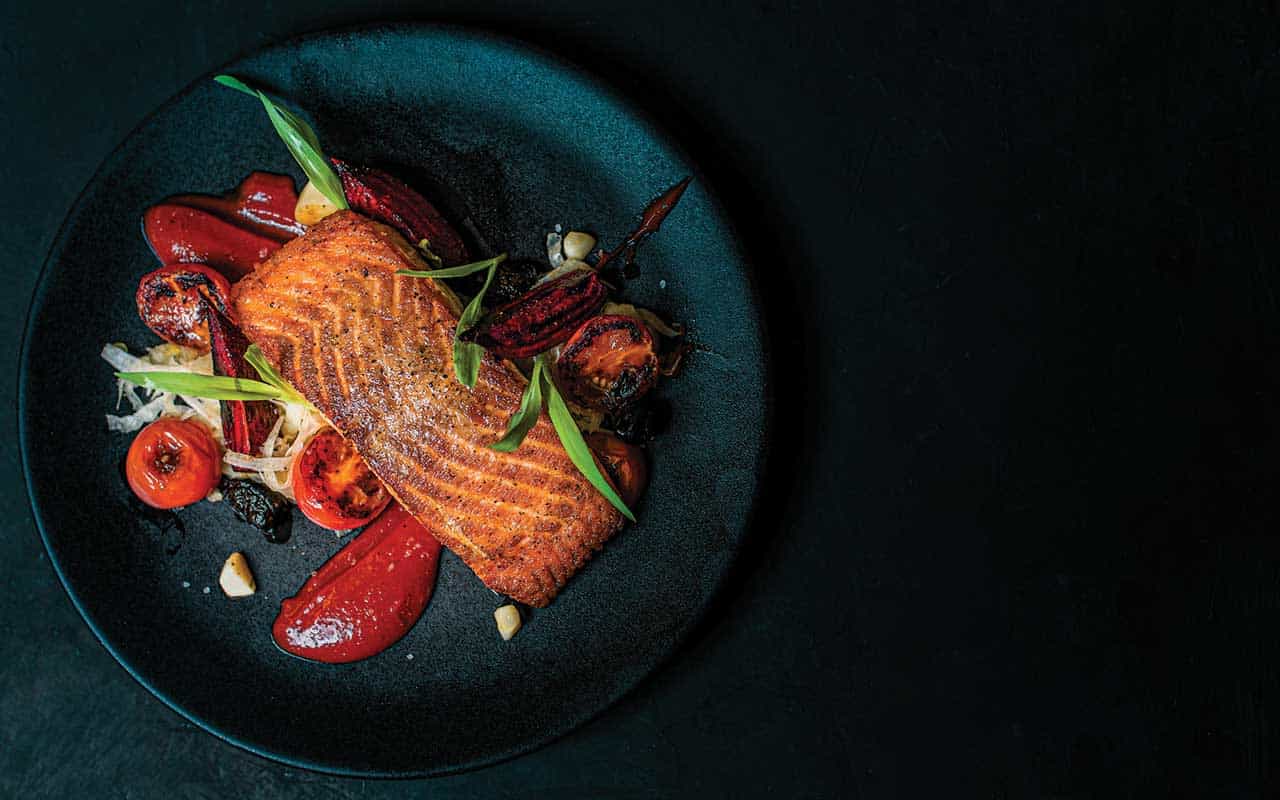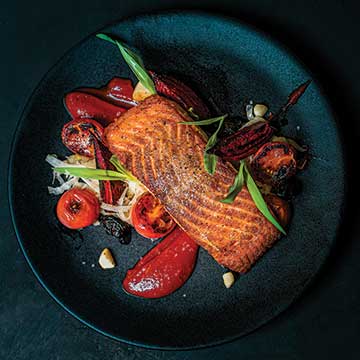This Month’s Featured Article

Mindful Eating
 Mindful eating for me as a child meant focused attention on the present moment but to a different end. With seven hungry kids sitting around the dinner table, we were mindful of eating as quickly as we could. The first one done got the last pork chop, or burger, or baked potato. I still carry this propensity to wolf down my food even though there are many fewer mouths to compete against in my family and I can have all the pork chops I want. This old habit is something that mindful eating can help me with.
Mindful eating for me as a child meant focused attention on the present moment but to a different end. With seven hungry kids sitting around the dinner table, we were mindful of eating as quickly as we could. The first one done got the last pork chop, or burger, or baked potato. I still carry this propensity to wolf down my food even though there are many fewer mouths to compete against in my family and I can have all the pork chops I want. This old habit is something that mindful eating can help me with.
According to Zen master Thich Nhat Hanh and Harvard nutritionist, Dr. Lilian Cheung, “Mindful eating is a way to incorporate mindfulness into one of the most fundamental activities of our existence. It’s a way to nourish our bodies and our minds. It is a way to help us achieve a healthier weight and a way to appreciate the relationship between the food on our table, our health, and the health of our planet. It is a way to grow our compassion for all living things and imbue reverence for life into every bite.” That’s a mouthful, so let’s take some time to digest the words.
Serving up mindfulness
Mindful eating, like meditation, is a form of mindfulness, which is paying attention to the present moment without judgment. Mindfulness allows us to focus our attention in the present to be truly aware of the activity we’re engaged in at the time, whether it’s meditative breathing or mindful eating. In contrast, mindless eating is when you finish a meal but can’t really remember eating it or what it tasted like. It’s distracted, unreflective, and fast.
When eating mindfully, we slow way down. We savor. We think about the food we’re eating, from its origin to our plate.
While there is a definite spiritual component to mindful eating, there are also distinct health and diet benefits that result in healthier eating through a more plant-based diet and a more sensible and intimate relationship with food.
Non-judgment
A key characteristic of any mindful activity is the lack of judgment, in this case surrounding food. There’s only awareness, reflection, and resulting behavior. Berating yourself about unhealthy choices and oversized portions is not part of the plan. Understanding why you make choices, noticing your feelings about them, and initiating baby steps to alter beliefs and behavior are what’s on the menu in mindful eating.
Hungry heart – or hungry belly?
One key aspect of mindful eating is a focus on what triggers eating in the first place – hunger. There are times when physical hunger, which should be the impetus to eat, takes a back seat to an emotional hunger that we seek to fill with food. If this is the case for you, awareness is the first step. Mindful eating experts recommend examining what’s prompting you to eat by asking some key questions that help differentiate between physical and emotional hunger:
- Am I experiencing hunger pangs?
- Is my energy running low?
- Am I feeling something that’s triggering a craving for comfort food?
- Am I looking to food to ease that emotion or stressor?
The answers to those questions dictate the appropriate response. If it’s physical hunger, then listen to your body’s messages and eat mindfully. If it’s emotional hunger, how can you manage your emotions in a way that doesn’t involve food? This could mean restructuring your habits, your time, and your access to food at those critical junctures. It could mean taking a walk, meditating, finding something to occupy your hands like knitting, reading, or coloring.
Dear food diary
Keeping a food awareness journal is one method to increase awareness of what you eat, when you eat it, and why. This can be as low- or high-tech as you like. Keep a notebook of that information. No flowery language or deep thought required – just the facts. If you prefer, there are food journal apps for your phone.
Photographing meals is also effective. Images of the food you consume can be more compelling than the written version. Using images, you can visually register portion size, the ratio of healthy vs. unhealthy choices, and frequency.
Proper prior meal planning
There’s no doubt that dedicating yourself to mindful eating takes time and diligence. This can begin with advance meal planning, shopping, and preparing. It may feel overwhelming to do that for three meals a day, seven days a week.
Start the process incrementally. This is critical because small changes breed success, confidence, and the desire to make further changes. What’s the low hanging fruit in your diet? What micro-changes can you implement that aren’t too painful? Here are some tips:
- Start with a meal you can easily tweak, such as breakfast. (Yes, studies show that skipping breakfast does negatively impact your weight and daily food consumption).
- Take a look at your snacking. Can you eliminate it? Convert that Snickers into a handful of nuts?
- Look at your dinner plate. Can you reduce portion sizes? Make veggies the main event instead of meat?
- Look at the clock. When do you eat? Can you shift meals so that you finish eating earlier in the day and stay away from the kitchen at night?
- Plan meals in advance. Shopping to the plan will help you stick to the plan.
- Make meals in advance. Pack your lunch the night before. Buy some cool bento boxes, bring a cloth napkin, and funky stainless travel utensils to make your packed lunch the envy of all your co-workers. It will also promote a more ceremonial approach to your office or school lunch.
- Look at your alcohol consumption. We all know that drinking doesn’t produce any kind of mindful behavior. Can you lighten up your drinks? Reduce their number each week, even by one?
Slow down
Speed is the mindful eating practice I need to work on. Eating slower is fundamental to mindful eating for several reasons. On a spiritual level, it allows us to reflect on the food we shop for, grow ourselves, prepare, and consume. In our fast-paced on-the-go lives, we have lost that reverential and sacred relationship to food. It’s become convenience over consciousness.
Slowing down and thinking about the provenance of our meal is part of mindful eating. Hanh and Cheung emphasize understanding where our food comes from and the relationships it embodies between the food itself; our health; the people, animals, insects, and organisms involved in its production; and the health of the planet. This kind of reflection and connectivity allows us to imagine the food chain that leads to our mouths and stomachs. It prompts us to seek more locally-grown options where the connections are more direct, as well as organic and less processed items.
Balance your budget against seeking out real and local food. Discern where you can forge that sacred relationship with food choices. Maybe you get veggies from the farmers market but Velveeta stays on the menu. Mindful eating is not about creating unnecessary stress or a bunch of “shoulds” or “oughts.” It reflects a desire to consciously do the best by your body, mind, soul, and planet.
Ways to slow down include:
- Talking about the food while preparing and eating – where it came from, how it tastes, how it’s prepared – with others in your household. Involve your whole family in preparation and eat meals together at the table.
- Slice and chop with awareness and focus on the task at hand – never a bad idea when a sharp knife is involved.
- Remove all screens, including your smartphone – they only lead to mindless eating and lack of awareness, which leads to eating too much.
- Embrace gratitude for the food, your health, and the planet. Keep your food connected to the universe. “Mindful eating sees each meal as representative of the whole cosmos,” write Hanh and Cheung.
- Take a few deep breaths before you begin eating and commit to mindful engagement with your meal. Sound like too much commitment? Start with a cup of tea and give it your full attention.
- Put down your fork between each bite. Try chopsticks if it slows you down further.
- Take smaller bites and chew, chew, and then chew some more. Then notice the swallowing reflex as the food travels down to your stomach.
- Take pleasure in each bite and really taste the flavors, notice the textures, sounds, and smells, explore the feelings that arise as a result.
- Put away any work or reading that distract you.
- Pull out the good china and crystal every so often. What are you saving them for anyway? Use cloth napkins, light some candles. Make meals special to the extent you can.
Exercises for mindful eating
Developing a mindful approach to food and eating is like a muscle that needs to be strengthened over time. Dr. Michelle May of Am I Hungry? describes the mindful eating cycle and useful questions to ask yourself.
- Why do I eat?
- When do I want to eat?
- What do I want to eat?
- How do I eat?
- How much do I eat?
- Where do I invest the energy I consume, i.e, what lifestyle choices do you make to help you burn food energy?
Another useful exercise is offered by Mindfulness-Based Stress Reduction (MBSR) expert Jon Kabat Zinn in the Raisin Meditation. It involves an intense focus on the facets of eating a single raisin, or any morsel of food.
- Hold: feel its weight
- See: be childlike and curious about it
- Touch: explore texture, close your eyes
- Smell: inhale the aroma, notice any physical sensations smell produces
- Place: notice how your arm bends and fingers place the raisin on your tongue
- Taste: notice the act of chewing and the sensations it produces as well as the change in its composition
- Swallow: think about the intention to swallow and then the sensation
- Follow: feel the raisin’s journey to your stomach and notice how you feel when you complete the exercise.
Mindful eating is not a diet. It’s creating a richer relationship between you, the food you eat and those who produce it, and the planet that sustains us. By building non-judgmental awareness of the present through food, we can dish up greater inner peace, conscious choice, health, and connectivity – and maybe lose a few pounds in the process. •
Resources: Websites with information about mindful eating include Dr. Michelle May’s “Am I Hungry?”, Dr. Susan Alber’s “Eating Mindfully,” Darya Rose, Ph.D.’s “5-Day Mindful Meal Challenge” and “Summer Tomato,” and the Center for Mindful Eating. The books “Savor: Mindful Eating, Mindful Life” and “Mindful Eating” by Thich Nhat Hanh and Dr. Lilian Cheung are clear discussions of the health and spiritual benefits of mindful eating. Meditation apps, such as Headspace have mindful eating modules.


